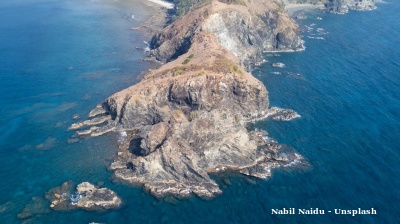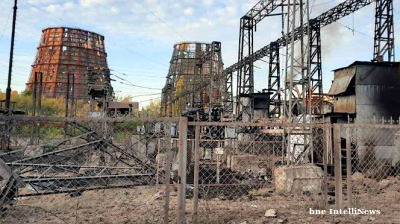Climate change is a “risk multiplier” for the South-East Europe region, which has already been identified as one of the world’s “warming hot spots” that will become increasingly vulnerable to heatwaves, droughts and other extreme weather events as global temperatures rise, says a new report from the OSCE and think-tank and public policy consultancy Adelphi.
The region comprising ex-Yugoslavia and Albania, which was racked by wars in the 1990s as the Yugoslav Federation disintegrated, is already prone to border tensions. Now the report, “Regional Assessment for South-Eastern Europe: Security implications of climate change”, identifies border hotspots across the region where rising temperatures and more extreme weather events risk worsening existing problems and adding to border tensions.
“Climate change will impact the region’s environment, economies and societies in complex ways, while also increasing the stress on political systems,” according to the OSCE report.
“While it does not directly cause conflict, it interacts with other pressures to influence security landscapes, including population growth, unequal economic development and resource constraints. In other words, climate change acts as a risk multiplier,” argues the report.
“Climate change is one of the most crucial issues of our time in the political, economic, social and environmental spheres. It can also emerge as a security issue when it interacts with other pressures such as unequal economic development, social inequality and resource constraints. These challenges can be tackled only through a multilateral and co-operative approach,” said OSCE secretary-general Helga Maria Schmid in a press release.
Examples of the way climate change amplifies existing risks are the altering of access to or availability of natural resources, which can lead to increased competition both within and across borders. At the same time, reduced efficiency of energy production, caused by both higher temperatures and lower precipitation, as well as threats to energy production and transmission infrastructure from extreme weather events, puts supply chains and energy security at risk, says the report. “Increasing demand for water and an unreliable supply puts pressure on existing water governance arrangements and can complicate political relations, particularly in transboundary basins that lack co-operation frameworks,” it adds.
On top of this, climate-induced extreme weather events and disasters “can aggravate political instability and put livelihoods at risk, which can be a push factor for people to migrate or turn to illegal sources of income. Finally, climate change can also affect food production and increase food price volatility. Rapidly rising food prices in turn can act as catalysts for social instability, violent protests and civil unrest.”
Four degrees hotter
At present South-East Europe is climatically diverse, wth subtropical Mediterranean southern and coastal regions, and temperate continental climates in the northern and lowland areas. It also has a unique and rich biodiversity, thanks to a range of habitats including coastal lagoons, wetlands, mountains, karstic terrains and Mediterranean forests.
A 2014 World Bank study identified South-East Europe as one of the world’s “warming hot spots”. It forecasts frequent heatwaves if temperatures rise by 4°C by 2100, a 20-50% drop in precipitation and a 20% increase in drought days. The fall in precipitation in summer would be accompanied by extreme precipitation events and more intense snowmelt in winter and spring, in turn leading to more flooding and landslides. Coastal areas would be affected by rising sea levels, while subtropical climates will shift towards the north, leaving coastal and southern areas hotter and drier in summer.
The biodiversity and ecosystems of South-East Europe “are under threat, as climate change is expected to cause a decline in suitable climate conditions, a slower natural migration of species and the degradation of many natural habitats,” said the report.
Some of these changes are already happening, with the impacts of climate change are already being felt across the region. The report points to the 1.2°C increase in average temperatures over the past two decades, and higher incidence of heat waves, droughts, flood risks and wildfires.
Wildfires are already common in the lowlands and hilly regions of South-East Europe, caused by a combination of heat waves, human action and poor forest management. Sometimes forest fires rage across international borders, like the September 2012 forest fires that spread from Albania to the Mavrovo National Park in North Macedonia.
Indeed, many of the region’s natural resources straddle borders, including six shared river or lake basins, among them the Sava River Basin, a major drainage basin in the region and the second-largest tributary of the Danube River by catchment area, shared by Slovenia, Croatia, Bosnia & Herzegovina, Serbia, Montenegro and Albania.
“Shared natural resources means common environmental challenges,” says the report. “Domestic waste, industrial waste and waste from illegal dumps and landfills often end up in trans-boundary rivers, creating problems for the region. Air pollution in urban and industrial areas is negatively affecting human health and the environment, while land use is also changing: despite the slowdown in urbanisation trends in recent years, people are still moving from rural or agricultural areas to cities and coasts, putting pressure on natural coastal habitats.”
Climate change will take its toll on human health, as heat waves are expected to decrease workers’ productivity and increase heat- and air pollution-related mortality. A warmer and wetter climate is also favourable for mosquitos that transmit diseases. Flooding brings further risks of disease on top of the direct threat to people’s lives.
Forests – which cover large parts of South-East Europe – are threatened by fires as well as higher temperatures, changes in rainfall patterns, flooding and the duration and frequency of droughts as the world warms. Illegal logging is another threat to the region’s forests.
Trans-border hot spots
The research identified 37 climate-related security hotspots, of which it designated seven as priorities.
Among them are two shared river basins – the Sava River Basin and Drin/Drim River Basin – that face risks from flooding, hydropower disruption and pollution as temperatures rise. “Transboundary co-operation on rivers is particularly important as the impacts of climate change affect all riparians,” says the report. “Even though transboundary water co-operation exists in the form of international agreements and regional basin management organisations, co-ordinated efforts need to be advanced to adapt to the impacts of climate change and avoid tensions.”
Mines – both active and abandoned – pose further threats. Several lead and zinc mines around the border between Bosnia and Serbia pose risks such as land degradation and soil pollution, water pollution due to the discharge of untreated industrial waste into waterways, as well as health risks. While no longer active, the Lojane chromium, arsenic and antimony mine in North Macedonia, near the Serbian border, has an unprotected tailings dump that is a pollution hazard.
“Inadequately managed or abandoned mining sites and the severe pollution caused by them are an important challenge in South-Eastern Europe, occasionally having transboundary impacts,” says the report. “Increased extreme precipitation events in winter and spring, as well as more intense snow melt and resulting floods or landslides, could increase these risks, particularly the failure of tailing management facilities. Experts warn that transboundary pollution could worsen tensions in the region.”
Three mountainous areas spanning two or more counties are also on the list of hotspots: Shar/Šara Mountains and Korab Massif area (Albania, Kosovo and North Macedonia), the Drina Valley – Tara Mountain area (Bosnia, Montenegro and Serbia) and the Sutjeska-Durmitor-Tara River Canyon (Bosnia and Montenegro).
The Drina Valley – Tara Mountain area, for example, faces risks of deforestation, wildfires, biodiversity loss, and soil and groundwater pollution. “Because the area is heavily reliant on agriculture and tourism, its economy is particularly exposed to climate change impacts,” notes the report.
Two priority regional challenges were also listed in the report. The first is air pollution, primarily from coal power plants but also from associated with cities and urban areas. Several reports have previously shown the damage air pollution does not only on the population of the Western Balkans – where most of the EU-aspiring countries are heavily dependent on coal – but across Europe as a whole.
Secondly, there is the movement of refugees and migrants into the EU via the region and the low employment prospects and economic opportunities that are driving large-scale emigration of its young and educated population to the EU. “The impacts of climate change will likely aggravate the existing economic situation and provide incentives for further migration and internal displacement,” says the report.
Economic damage
Climate change is forecast to take its toll on the economies of countries in the region, of which all but two (Croatia and Slovenia) are not yet EU members. Pre-coronavirus (COVID-19), the economies had been growing and unemployment had fallen to record lows. However, the coronacrisis caused GDPs to slump in 2020, especially in tourism-dependent Albania, Croatia and Montenegro, and high current account and budget deficits in some countries make responding to and recovering from the pandemic more challenging.
“The lack of fiscal buffers makes it difficult for economies in the region to handle external shocks, some of which are climate-related: in the period 2017-2019, for example, droughts significantly reduced hydropower energy production in the project region, especially in Albania and Bosnia & Herzegovina,” says the report.
Two of the region’s main sectors, agriculture and tourism, are “very climate-sensitive and are expected to be negatively affected by climate change, leading to a potential loss of livelihoods and jobs,” warns the report.
“Looking into the future, this could contribute to political discontent and pose challenges for political stability. In addition, negative climate change impacts could put pressure on vulnerable groups to migrate or to take up adverse livelihood strategies, including crime.”
Most of the region’s energy comes from burning locally produced coal and lignite, or from hydropower. “These energy sources will increasingly be affected by climate change,” says the report. “Coal-based energy production might face increasing pressure, as it is a leading emitter of CO2, while less water availability poses risks for hydropower production, leading to interrupted electricity supply and higher prices. This could further exacerbate energy poverty, which is already a major challenge in parts of South-Eastern Europe. In addition, environmental damages and water shortages caused by hydropower plants [HPPs], especially many smaller ones, have led to protests and blockades of construction sites and roads in the past.”
Features

Andaman gas find signals fresh momentum in India’s deepwater exploration
India’s latest gas discovery in the under-explored Andaman-Nicobar Basin could become a turning point for the country’s domestic upstream production and energy security

The fall of Azerbaijan's Grey Cardinal
Ramiz Mehdiyev served as Azerbaijan's Presidential Administration head for 24 consecutive years, making him arguably the most powerful unelected official in post-Soviet Azerbaijan until his dramatic fall from grace.

Ambition, access and acceleration – Uzbekistan’s Startup Garage opens free academy for entrepreneurship
Aim is to train 50,000 young founders by 2030.

Ukraine’s growing energy crisis promises a cold and dark winter
Since the summer, Kyiv has changed tactics. Given the almost complete failure of Western oil sanctions to curb Russian oil exports, it has been targeting Russian oil refineries. The Kremlin has struck back, targeting Ukraine's power system.




